






















14
LEGISLATIVE UPDATE
California Compliance Issues to Watch in 2023
Knowledge to guide your clients through compliance
BY MISTY BAKERThe new year brings a number of new legislative and regulatory issues that brokers need to be aware of in order to guide clients through compliance.
Watch Out for These Commission Trends in California
MAPD developments you should pay attention to
BY PHIL CALHOUNThe following is a discussion on commission trends for Medicare Advantage Prescription Drug (MAPD) taking place in California that directly affect broker income.
18
A Broker’s Playbook to Win Every Game!
Why and how the SIGNIFICANT always finish strong
BY DAN CLARKTo me, a broker is a head football coach/ on the field quarterback who both plays and leads, noting that yes, we win and lose as a team — but we win and lose BECAUSE of individuals!
Cal Broker’s commitment is to be the leading source of news and information for California brokers and agents operating in the health, life, and annuity industry. We are committed to connecting Life and Health insurance professionals to valuable resources and solutions they can provide to their insurance clients.
2023
Originally included in Sept. 2022 and updated for this edition. Focus on making our businesses run more efficiently so that we are better positioned to respond to client needs.
24
The Role of Brokers in the 2023 Employee Benefits Market
3 ways brokers can help clients navigate workplace challenges
BY CHRIS DELLA SALAFor brokers in the employee benefits market, 2020 accelerated and exploited trends, like virtual work, that were already slowly and steadily disrupting the market.
THIRD OF FOUR INSTALLMENTS:
Emotional rollercoaster reaches solid ground
BY AMY EVANSMy plan was not to retire but to work with a larger group offering more resources for my clients and an opportunity to further my career.
28
Generational Leadership: Part One of Two — NAHU Leadership Perspectives Shift to Embrace the Generations
A conversation with favorite mentors Bruce Benton and Pat Griffey
To be continued with commentary by Joe Navarro in January 2023
BY DAWN MCFARLANDAs we conclude 2022 and prepare for 2023, I find myself naturally evaluating how the year went professionally and personally.
32
Tap into the Vein of Gold Below the Voluntary Benefits Goldmine Five Tips to Make 2023 a banner Year
BY JOSHUA SCHNEELOCHThe end of year is one of the most exciting and rewarding times for voluntary benefits agents and their employer clients, as well as the workers who will enjoy enhanced worksite benefits.






PUBLISHER
HealtH Broker PuBlisHing, llC publisher@calbrokermag.com
EDITOR
Linda Hubbard Lalande editor@calbrokermag.com linda@calbrokermag.com
ART DIRECTOR Randy Dunbar Randy@calbrokermag.com
VP MARKETING
Devon Hunter Devon@calbrokermag.com
CIRCULATION calbrokermag@calbrokermag.com
EDITORIAL AND PRODUCTION:
editorial and ProduCtion
Health Broker Publishing 14771 Plaza Drive Suite C Tustin, CA 92780 (714) 664-0311
34
Assisting Your Clients With Prescription Drug Coverage Critical guidance to offer during AEP
BY MARGARET STEDTMany agents are reluctant to assist clients with exploring the prescription drugs plans that best fit their needs.

36
PUBLISHER’S PICK: BOOK REVIEW
“The Price We Pay: What Broke American Health Care — And How to Fix It”
BY PHIL CALHOUN, CALBROKER PUBLISHERcalbrokermag@calbrokermag.com
Subscriptions and advertising rates, U.S. one year: $100. Send change of address notification at least 20 days prior to effective date; include old/new address to: Health Broker Publishing 14771 Plaza Drive Suite C • Tustin, CA 92780 714-612-0306
California Broker (ISSN #0883-6159) is published monthly. Periodicals Postage Rates Paid at Burbank, CA and additional entry offices (USPS #744-450).
POSTMASTER: Send address changes to California Broker, 14771 Plaza Drive Suite C • Tustin, CA 92780
©2022 by Health Broker Publishing. All rights reserved. No part of this publication should be reproduced without consent of the publisher.
No responsibility will be assumed for unsolicited editorial contributions. Manuscripts or other material to be returned should be accompanied by a self-addressed stamped envelope adequate to return the material. The publishers of this magazine do not assume responsibility for statements made by their advertisers or contributors.
Printed and mailed by Southwest Offset Printing, Gardena, Calif.
Stories of disruptive healthcare innovators and the new movement to restore medicine to its primary mission to help people.
38
VOLUNTARY BENEFITS
The Power of Vision Benefits Why Employees Need Eye Exams and Premium Vision Benefit Plans
Vision problems cost U.S. employers $575 billion in lost productivity
BY JONATHAN ORMSBYWith many workers continuing to experience visual demands on their eyes, from blurry vision to eye fatigue to headaches, taking care of eye health remains an extremely important part of our overall health.
40
VOLUNTARY BENEFITS Q&A
Everything You Need to Know about Voluntary Benefits
But didn’t have time to ask!
Here’s an in depth perspective on voluntary benefits from experts in the field. We asked three thought leaders to answer a series of questions to help inform you about this important realm of benefit offerings.
Industry News 9 Ad Index 46





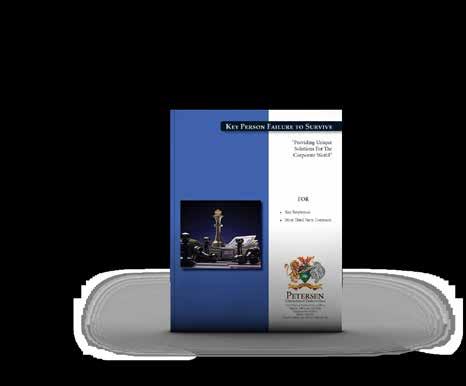




The business world thinks about post-pandemic flexibility as the ability to choose where we work. But being able to choose when we work may be far more important. Employees with flexible schedules report 29% higher productivity and 53% greater ability to focus than those with set hours, according to the Slack Future Forum’s latest research, which surveyed more than 10,000 desk workers around the world.

The place also matters, but not nearly as much as time. Workers who chose where they worked were 4% more productive than their fully in-person counterparts. The labor market remains hot, and if companies take away flexibility, their workers can walk and look for new jobs. Employees who can’t set their own hours are twice as likely to look for new jobs as those who can.
From axios.com https://bit.ly/3GvkDjv
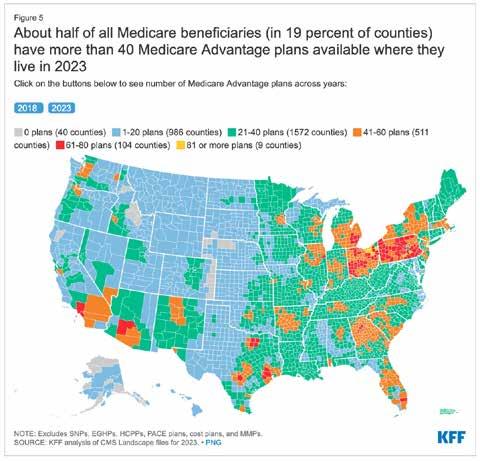
As Medicare Advantage continues to grow, a gradual but significant reshaping of the Medicare program is taking place.
A new KFF analysis finds that nearly half of eligible Medicare beneficiaries — 28.4 million out of 58.6 million Medicare beneficiaries overall — are now enrolled in Medicare Advantage plans. That represents a more than doubling of the share of the eligible Medicare population enrolled in such plans from 2007 to 2022 (19% to 48%). Enrollment is projected to cross the 50% threshold as soon as next year, making Medicare Advantage the predominant way that Medicare beneficiaries with Parts A and B get their coverage and care.
Medicare Plan Finder likely won’t note new $35 cap
In August, Congress approved a $35 cap on what seniors will pay for insulin, but that change came too late to add to the online tool that helps Medicare beneficiaries compare dozens of drug and medical plans. Federal officials say beneficiaries who use insulin will have the opportunity to switch plans after open enrollment ends Dec. 7, 2022.
Teens and Young Adults SelfDiagnosing Mental Illness On TikTok. What Could Go Wrong?
On the positive side, the TikTok videos (or postings on other social media sites) can give people insight into themselves and propel them to seek professional help, experts say. If you look for it, it’s even possible to find content from actual mental health experts, and all this attention on mental health is bringing what was once a taboo subject into the light. But too often, experts say, suggestible people mistake having one or two symptoms with having the disorder itself. Boston Globe via KFF.org

Sponsored by TWH Annuities & Insurance Marketing, Inc.

Market volatility, inflation and an evolving interest rate environment could send many consumers to their financial professionals to reevaluate their retirement strategies. Those seeking greater security may be interested in learning about fixed indexed annuities, which have a unique combination of features that are beneficial to retirees.
FIAs help many individuals approach retirement with equanimity, less concerned with volatile markets or outliving their assets and more willing to pursue growth opportunities. Dive deeper.
Contact: www.twhagency.com 800-200-9194
Blue Shield announced that UC San Diego Health will join their Trio HMO and Local Access+ HMO networks for San Diego County effective Jan. 1, 2023. This addition expands members’ access to many providers in UCSD Health’s comprehensive network who are already available on the full HMO Access+ network. https://bit. ly/3X7t0HS
Four Major California Employment Law Changes For 2023
California employers will see a number of changes affecting human resources in the new year. Major themes include compensation and leave, but employers also will need to note legislation that adds new retaliation protections for workers, attorneys told HR Dive. https:// bit.ly/3GzRP9w
Medicare’s Annual Enrollment Period (AEP) began on Oct. 15 and many seniors are already reviewing their coverage options — but not enough of them. This survey of over 1,000 Medicare beneficiaries shows significant numbers are poorly educated about AEP or unaware of changes to their current plan that may take effect next year. Most are enrolled in the same Medicare coverage they had three years ago, though about half admit their prescription drugs needs, the doctors they see, and their personal finances have changed in the past year good reasons to review new plan options. Link to survey here: https://bit.ly/3EqpsYG. Take a look at another eHealth survey for more Medicare consumer insights here: https://bit.ly/3OlfJHG
California is collecting hundreds of millions of dollars a year in tax penalties from uninsured residents. The state was supposed to use the money to help lower costs for Californians who couldn’t afford insurance but hasn’t distributed any of the revenue it has collected — citing uncertain economic times. Read more here: https://bit.ly/3AgYlhB
Starting Jan. 1, 2023, a new law will require most types of insurance producers, as well as independent insurance adjusters, public insurance adjusters, and analysts, to include their license number on emails. (California Insurance Code section 1725.5, as amended by Senate Bill 1242 (Committee on Insurance, Chapter 424, Statutes of 2022).

This Notice answers some of the most common questions about the new law.
Which types of insurance license does the law apply to?
The law applies to individuals and organizations licensed as:
• Property broker-agents
• Casualty broker-agents
• Life agents
• Accident and health or sickness agents
• Personal lines agents
• Limited lines automobile insurance agents
• Surplus lines brokers
• Independent insurance adjusters
• Public insurance adjusters
• Life and disability insurance analysts
https://bit.ly/3VbwXtn
The “family glitch” arose when the IRS released clarification of regulations related to the affordability requirements of coverage offered by employers with 50 or more full-time workers or equivalents, also referred to as ALE’s.
The glitch stems from 2013 guidance from the Treasury Department and the IRS. The final rule revises the definition of “affordability” of employer-sponsored coverage as it applies specifically to family members of the employee. Most of the rule goes into effect for the 2023 tax year, meaning family members who qualify can enroll in subsidized marketplace coverage for 2023.
The great news for employers is that this change does not mean a direct increase in cost for them. With the fix, family members who are offered unaffordable job-based family coverage will be newly eligible for subsidized marketplace coverage.
JorgensenHR free Labor Law Update Webinar Dec. 6, 10 am PST
Guardian Life + Spring Health Mental Wellness Webinar Series Dec. 14, 9 am PST, Grief & Loss. Online live, and on demand.
Money 2.0 Conference White Wing CEO Joshua Schneeloch will present with other experts. Dec. 19-21, Las Vegas.
NAHU Live Virtual Corporate Wellness Certification Jan. 24, 10:00 AM to 1:00 pm PST
70th Annual Will G. Farrell Award & Leadership Recognition Event Feb. 23, 11:30 am - 1:30 pm PST by Zoom Sponsored by NAIFA-LA and FSP Info: janet@wifs-losangeles.org
WIFS-LA Women’s Forum “Embrace Empowerment” Mar. 4, 9:00 am to 1:30 pm PST, by zoom: wifs-losangeles.org/events/ Ellevate Women’s Leadership 2023 Summit March 13-15, 2023, Las Vegas
CAHIP Capitol Summit May 8-10, 2023, Sacramento

Please answer our four survey questions
CMA’s new requirement for annual enrollment period (AEP) involves recording calls with Medicare clients. To comply, health insurance professionals need to figure out how to not only record calls compliantly but to download calls on demand. When assisting clients with MAPD and PDP plans, the new call recording requirement has generated some responses.
Here is a sample of one broker’s experience.
1) Have any clients opted out of the recording? What percent?
None of my clients have objected to being recorded. They understand and are used to the recorded calls through customer service lines.
2) Scale of one being “not well” to 5 “just fine,” how are the required recordings going so far?
My clients are fine with being recorded but a number are annoyed that I cannot set appointments or review other coverage issues and plans without calling through the system’s recorded number.
3) Scale of one being “not at all” to five “totally agree,” do you now think recording calls is a best practice that benefits your clients and you?
The new call requirements create more administrative and time-consuming work. I must enter the individuals in the database to be able to call from it. This causes delays in my turnaround time for service, a key unintended consequence.
4) Did your FMO help you get the recording setup? If not how did you do get ready?
The call system is provided by my FMO. Some flaws exist which I hope can be resolved. It should have a good identifier
— such as my name — change when the call appears as “caller not known” or as spam so the prospect/client will pick up the call. This would eliminate the need to have to call the individual and tell them that I will be calling them with those identifiers.
Added comment: I do like the ease of the system for making or receiving calls, the electronic records created and records management for the clients and prospects. It is important to note that with the number of unsolicited and general spam calls, the Medicare beneficiary is very wary of calls they are receiving under this new call system. This often makes me look like one of the bad actors instead of a trusted advisor (the agent of record).
To share your experience, please respond to our survey: “Call Recording: How Was your Experience.”
Here’s the QR code to our very brief 4-question survey.

or you can go online here: https://bit.ly/3tHDgcv download the questions and email them to publisher@calbrokermag.com.
We will keep the survey open through January so finish AEP, take a break and please take a moment to complete the survey.
The results will be posted in all Cal Broker media — website: calbrokermag.com, Insurance Insider eNewsletter and our monthly magazine.
MedicareCENTER.com is a proprietary software platform, designed to deliver a crucial new solution that is incredibly simple to use — Call Recording! Agents needing a smart and efficient way to stay compliant can use the MedicareCENTER’s Call Recording program. It’s easy to seamlessly record all sales calls, store the recordings compliantly and download calls at any time, from anywhere. This solution is built just for Integrity agents and available at no cost in MedicareCENTER at medicarecenter.com/welcome
Watch a brief video to learn how Call Recording in MedicareCENTER can help agents stay compliant and have more time to focus on what they do best — serve Americans!
https://www.integritymarketing.com/announcing-call-recording-in-medicarecenter/
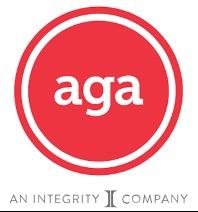
The new year brings a number of new legislative and regulatory issues that brokers need to be aware of in order to guide clients through compliance. On the national front, there are a number of questions around the Consolidated Appropriations Act, with some elements going into effect in 2023, while others have been postponed. The results of the midterm elections have the potential to change control of state and national legislatures, which will impact the types of bills that are introduced and passed.
While it’s important to stay on top of these national issues, there are also five pieces of California-specific workplace legislation that brokers and clients need to be aware of going into the new year.
Signed into law by Governor Gavin Newsom in September, SB 1162 goes into effect on Jan. 1, 2023. The legislation amends California’s Pay Transparency Law, expanding reporting requirements around pay scale and requiring employers to make salary ranges for positions available to both employees and applicants.
The goal of the enhanced reporting requirements, which include employee sex, race, and ethnicity, is to better identify pay disparities based on gender and race. By collecting and segmenting data at this level, it will be easier for employers to identify and address pay disparities between specific groups of employees.
For employers that already have a structured pay scale or set of steps to determine compensation for new positions, compliance will be less onerous. For those that do not have guidelines for setting compensation ranges, it’s time to get a process in place.
The California Privacy Rights and Enforcement Act (CPRA) amends the California Consumer Privacy Act (CCPA) and will go into effect on Jan. 1, 2023. The CPRA removes some employer exemptions found in the CCPA and introduces new privacy requirements. Specifically, employers must:
● Notify both applicants and workers (employees and contractors) about the types of personal information that the employer is currently collecting or may collect in the future, as well as the purpose of collecting and disclosing that information. This includes explaining how the information is being shared and to whom.
● Detail employees’ rights regarding accessing or restricting the disclosure of certain categories of personal information.
● Provide employees a way to correct or delete collected personal information, subject to statutory exemptions.
● Allow individual employees to request any personal information that was collected on them during the preceding 12 months.
Effective Jan. 1, 2023, the minimum wage in California increases to $15.50 per hour. This change is effective for all employers. Previously, minimum wage increases applied only to employers of a certain size. With this increase, there are no exceptions.
While this change sets the minimum wage for the state, some cities have their own minimum wage thresholds that are higher than the state’s.
AB 1949 and AB 1041 extend unpaid leave to cover more employee relationships
Under AB 1949, private employers with five or more
employees, as well as all public employers, must provide up to five days of unpaid bereavement leave for the death of a family member. Family members are defined as spouses, children, parents, siblings, grandparents, grandchildren, domestic partners, and parents-in-law. Employers may require employees to provide documentation on the need for leave. Additionally, the leave must be completed within three months from the family member’s death.
Additionally, AB 1041 modifies the California Family Rights Act, which allows employees to take up to 12 weeks of unpaid leave per year for family caregiving. Recognizing that the original Act was limited in its definition of relationships that constitute “family,” the new legislation allows employees to identify a designated person at the time they are requesting leave, without requiring the designated person to be an immediate family member. Employers may limit employees to one designated person in a 12-month period, but eligible relationships may now include aunts, uncles, cousins, friends, and non-dependent children.

While AB 2188 does not go into effect until January 1, 2024, employers should be keeping an eye out for additional guidance throughout the year. AB 2188 makes it unlawful to discriminate against employees and applicants based on offduty/off-premises cannabis use.
On-the-job and pre-employment drug screenings are still permitted, as long as they do not test for non-psychoactive cannabis metabolites. Additional guidance is needed to determine if and when impairment tests are permitted. Tests for tetrahydrocannabinol (THC), the psychoactive compound found in cannabis can indicate impairment and are still
allowed under the law. Employers will need to review and update their current drug testing policies and procedures ahead of 2024.
It’s important to note that AB 2188 does not apply to certain trades or employers, employees, or applicants who are required by law to be tested. (This includes, but is not limited to, tests required by federal contracts, licensing boards, and security clearances.) Employers should carefully review the law and its exemptions to ensure proper compliance.
MISTY BAKER is director of compliance and government affairs, BenefitMall and serves as the 20222023 Legislative Committee Chair, NAHU/NABIP. She is an Affordable Care Act Compliance, Agent and Industry Advocate. specializing in ACA, ERISA, FMLA, COBRA and legislative advocacy for more than 20 years. She is passionate about delivering real-world and easy to understand solutions for clients, agents and broker concerns in this ever-changing health insurance market.
In 2015, Misty was recognized as one of the Most Influential Women in Employee Benefit Advising, by Employee Benefit Advisor. She served in the local, state and national leadership and advisory programs, and has been awarded with more than 10 awards for legislative efforts, agent advocacy and leadership.
Contact: www.Benefitmall.com

The following is a discussion on commission trends for Medicare Advantage Prescription Drug (MAPD) taking place in California that directly affects broker income.
Wellcare does not offer brokers the opportunity to transfer commissions. This decision prevents brokers who write MAPD with Wellcare the ability to pass their commissions on to anyone should they no longer be able to stay active due to disability. Equally concerning is this blocks the broker’s ability to sell commissions and enjoy the benefits of their years of arduous work.
UHC has a program for high performing MAPD brokers. Select brokers are awarded higher payments under the National Marketing Alliance. Success is rewarded — but then a surprise for some comes when they find they have limited transfer options for retirement.
High performing brokers with UHC may also face this issue. If you are paid extra for selling UHC MAPD plans, you need to know if you will face limitations upon the sale or transfer of these commissions. It is better to read the fine print now and determine whether there is a transfer/sale option upfront rather than learning there’s a limitation in the middle of a sale or transfer with a commission buyer. In essence UHC has determined that only select National Marketing Alliance brokers can receive a transfer of UHC MAPD commissions.
Many retiring brokers have a trusted buyer — perhaps a colleague or relative — but learn there is no option to get these commissions transferred to them. The result is there is no value in their UHC MAPD book of business. Their only option is to continue certifying annually to continue their commissions.
Somehow UHC put this program in place and brokers gladly accepted the higher payment without realizing they gave up the right to sell or transfer this business.
Brokers do appreciate rewards for their arduous work and success enrolling individuals into medical plans for carriers. This also proves the point that brokers need to read the fine print to be aware of surprise restrictions.
As a top producer for UHC MAPD plans, Barbara shared how she worked for years with UHC. Due to her successful Medicare work in her retirement arrangements, she planned to sell her MAPD book of business and only stay active with Medicare Supplements. When she checked with each carrier on their commission transfer process, all the carriers except UHC allowed her commission transfer to go through. She was surprised that none of UHC commissions were transferable — MAPD, PDP and Medicare Supplement. She discovered her designation as a top producer for UHC MAPD was the result. While Barbara was pleased her son was joining her in the business she was highly disappointed that even with his certification with UHC, the transfer of MAPD commissions was blocked. Barbara is hoping that with enough pushback from brokers, UHC will consider changing this decision.
If you have commission success or challenge stories to share, please send them to publisher@ calbrokermag.com. We plan to continue to inform health brokers of commission issues they need to know.
Health insurance professionals are increasingly exploring retirement. Many consider selling their book of business at some point. With 70% of all health brokers aged over 65, research shows that within the next 12 years these brokers will need a plan to transfer their book of business.
Typical choices for exit planning are through the sale of commissions, a merger with an agency, or an internal sale/transfer to younger employed brokers. In any of these cases, we encourage commission planning. When appropriate, find a professional to help coach you through the exit planning process.
In our commission solutions practice, we find 2 out of 5 brokers decided, after considering their options, to work another year. This led them to push through 2023 AHIP and carrier certifications and do the work to renew clients during 2023 AEP.
We also found 40% of brokers with MAPD business we worked this year on exit planning made the decision to stay active with MAPD and PDP for another year.
The brokers who chose to stay in the game will consider selling in 2023. This decision comes after exploring exit options and timing. What they report is how valuable it was for them to learn how to protect their commissions while staying active and conducting business as usual.
“Of our broker clients who made the decision to stay active and postpone the decision to retire, all decided to protect their commissions with a formal written agreement,” David Ethington of Commission Solutions shared. “In our role, we help educate brokers through this process. When called for, we match them with a qualified successor. We create a written agreement covering legal aspects of the protection work the active broker requires.” Being able to answer the question of a client or prospect, “Do you have some who will help me should you retire?” is one of the benefits for brokers who complete a commission protection plan. They have a confident response of “Yes, you will be taken care of. I have a formal backup plan in place with my successor.”
PHIL CALHOUN operates a commission planning consulting service. Phil’s book — published in 2020 — and his education programs have helped thousands of health insurance professionals learn how to protect 100% of their health commissions.
For a free copy of the book, “The Broker’s Guide to: Protect, Grow and Sell Health Commissions” go to www.healthbrokersguide.com.
Contact: phil@commission.solutions or 714-664-0311
DAVID ETHINGTON is VP of the Medicare Division and director of Broker Relations with Commission Solutions, Integrity Advisors. His work has excelled due to his commitment to provide the best service to both health clients and health brokers. David respects the hard work it takes to build a book of business and enjoys working with retiring brokers. He serves on the board of Directors for Orange County Association of Health Underwriters (OCAHU).
David has participated in the commission protection process for seven years He’s also involved in acquisitions, especially in the broker relationship transfer of commissions. David lives in Orange County with his wife and their cats. He is an avid runner and completes several long-distance events annually.


Contact: (714) 664-0605 david@integrity-advisors.com
Get informed for 2023. Learn more at www.commission.solutions. Access the planning pathways for active brokers and for brokers looking to sell.
The dictionary defines insurance broker as “An intermediary who sells insurance by negotiating with multiple insurers on behalf of a client for compensation; while an agent represents one or more specific insurers under a contract.”
To me, a broker is a head football coach/on the field quarterback who both plays and leads, noting that yes, we win and lose as a team — but we win and lose
BECAUSE of individuals!
Once we are fully prepared and qualified to put our best foot forward, we then coordinate and collaborate with our teammates to accomplish more together than we can apart. My favorite example is when a firefly lights up by itself to attract a mate — it only has a 3% chance of attracting one. When a community of fireflies lights up in sync, the chances go up to 82%! When we help others become better, we can actually increase the available opportunities, instead of vying for them. All begin to shine brighter, both individually and as an ecosystem. We become a positive unstoppable system of choice. The more you help people find their light, the brighter you both will shine.
Isn’t this why we subscribe to California Broker Magazine? Isn’t this why you join NAHU and CAHIP, attend your national conferences and fully participate in gatherings like Senior Summit and many others? Isn’t this how you attract more minorities, women and younger agents into this most noble profession of insurance providers?
Because the world of insurance illuminates a complete perspective on physical/ mental health, any agent can discuss ensuring the quality of life, long term care, and the reality of death. But if you’re serious about being an Extraordinary and Significant broker who stands out among your peers as an industry icon, it is critical to comprehend and be able to share the biggest picture, answering: Where did we come from, why are we here, and where are we going?
Life is a three-act play — and if you come late to the theater and don’t know what was in the first act — the second and third acts have incomplete meaning! And if you don’t stay for the third act finale so you know how the play ends — the first and second acts have no purpose!
Part of my answer to “Where I Came From” includes a rare opportunity to soar to the edge of space in a U2 reconnaissance aircraft — illuminated in a documentary on YouTube: danclarkYouTubespyplane.
In a sortie that lasted five hours, I sat in the sounds of silence at 90,000 feet, witnessing the breathtaking curvature of the earth, gazing into the endless blackness of the universe, pondering eternity and my place in it. And with a 17-mile-high unobstructed view of Mother Earth, I teared up. I experienced that we are more than mere mortal beings, living on a small planet, for a short season. We are all interconnected beings — literal brothers and sisters in the family of humanity – living together in a world governed by a specific set of universal laws — established for the sole purpose of assisting us to achieve a level beyond success — a level I call “The Art of Significance.” You see, successful people get what they think they want. For those of us who are striving to live a life of significance, we have to make

sure we WANT what we get — so we don’t die with our music still inside of us.
The SUCCESSFUL individuals begin with the END in mind — a limiting belief that forces them to focus on a destination that’s impressive, do their best to manage people, and reward results. Thinking they can go to the gym once — lose 20 pounds once — get married and the rest is bliss — compete against others and win a race — primarily work pretty exclusively during the Annual Enrollment Period.
flight! In fact, not only did I eject bananas from the night before — I ejected a box of Reese’s Pieces I had eaten at a movie when I was seven!
And yes, this knowledge would have kept me from ever flying Mach II again! But because I quickly became emotionally addicted to the thrill of 9gs, aileron rolls, barrel loops and bombing runs — I have pushed myself to go supersonic time and again — being upside down so many times I think I’m the only human being who has ever thrown down! (Ha!)
In contrast, SIGNIFICANT individuals (brokers) begin with the WHY in Mind, which inspires and empowers us to focus on the journey that’s important, manage expectations and reward effort. Knowing we must exercise every day — we realize “happily-ever-after” is a day at a time proposition — the only person we need to be better than is the person we were yesterday — and you focus year-round on visibility/service/community involvement to position yourself so when people DO need to enroll they think of you!
Awe-struck in the journey of space, it was obvious to me that everything we can take with us when we die I had aboard with me on that aircraft — my Knowledge/Beliefs, my Character, my Degree of Improvement — and the Memory of whether I lived a life of Service Before Self!
In a previous article (Why Choose You, Oct. 22) I reminded readers: Knowledge is power, but it has no heart! Reason leads to conclusions, but it is EMOTION that leads to action. It’s Emotional Intelligence that takes us from where we are to where we want to be!
However, in reference to the release of the Top Gun Maverick movie, let me shed additional wisdom: ‘It’s not the plane, it’s the pilot’ — ‘Don’t think, do!’ Every time I’ve flown a fighter jet, or a bomber, and when I climbed aboard the U2, it’s clear that we fly them by ‘feel.’ We become the plane. When we climb up the ladder and slide into the cockpit, we don’t strap into the jet — we strap the jet onto us!
And it doesn’t matter if I’m male or female, old or young, black, brown, or white — the jet does not care! Are we qualified and experienced enough to push it to its limits? Not just with my cognitive, neuromechanical, left brain — but with my relational right brain, intuitive, Emotional Intelligence that triggers passion, unleashes creativity, and demands innovation?
FYI: Yes — I popped my cookies in my first fighter jet
In terms of time: Today you’ve never been this old before. And today you’ll never be this young again. So right now, and every right now matters. Which means no matter what your past has been you have a spotless future. Which means you can’t always control what happens, but you can always control what happens next!
In a football game, not every play is designed to score a touchdown. One play sets up the next play, which sets up the next play, never taking a play off, until you finally score. If you are behind in the game, there is nothing more insignificant than the half time score! You make an adjustment, knowing there are no 21-point plays and move the ball quickly, one sale, one enrollment application at a time.
Yes, this is obvious. But why then, do so many still refuse to be present in the moment? It’s because their present sucks! So they medicate.
Or they live in the past — which is as absurd as robbing your old house, when you don’t live there anymore!
Or they live in the future — which is fruitless — explained by Pascal who cautions: ‘Too many live their lives hoping to be happy — but because they only hope, they never really are!’ And —‘Faith without works is not faith at all.’
The good news is that being present in every moment simplifies life into two choices — will you react or respond? Especially when you stumble or fail. I was at a meeting where an 87-year-old woman stepped to the podium to deliver her speech, and accidentally dropped it on the floor. With 3x5 cards everywhere she said, “I’m sorry I’m so nervous. I gave up beer for Lent and this whiskey is killing me!” (Ha!)
Character begins to develop when we acknowledge that Adversity introduces us to ourselves — no one knows how strong we are until being strong is our only choice!
is that being present in every moment simplifies life into two choices — will
To illustrate, I was a projected number ONE pick by the Oakland Raiders in the NFL draft, and then suffered a career ending injury that left me paralyzed for 14 months. I went to 16 doctors — 15 of whom told me I would never recover — I would never get any better.
Have any of you ever heard this? What happens if you believe it? You never get any better. And I hit what I thought was Rock Bottom. My heart was broken, my dreams were shattered, my identify was taken, and suicidal thoughts attacked my soul.
But in the tranquility of flight, I suddenly realized that this injury was one of the best things that has ever happened to me. Don’t misunderstand. My paralysis wasn’t one of the best things that has happened — but who I’ve become as a man and what I’ve learned about life and priorities because of this setback made it a significant emotional event.
Which made me reflect on three questions:
Question #1. Why did I go to so many doctors?
I kept going from doctor to doctor until I found one who BELIEVED I would get BETTER! Belief determines how we experience the world! Our beliefs have the power to create and the power to destroy! The outer conditions of a person’s life will always reflect our inner beliefs, knowing: “It is not enough to say I will do my best. We must succeed in doing what is necessary!”
Question #2. What did I mean, I thought I hit Rock Bottom?
No one ever hits Rock Bottom. We hit Rock Foundation —
we hit Rock belief. We hit the baseline Core Values on which we were raised — we hit the baseline Governing Principles on which our organizations were built!
“Under pressure you don’t rise to the occasion – you fall to your level of training. That’s why we train, practice and prepare so hard!”
Question #3. What took me so long to
I was asking the wrong questions. I was asking the doctors HOW to get better — when I should have been asking myself WHY. Once we answer WHY — figuring out the HOW-TO becomes clear and simple. When our ‘why’ is bigger than our ‘why not,’ we can endure any ‘how!’
Every great person we admire didn’t succeed because of one giant move, but because of a series of consistent actions over time. While successful people focus on the destination outcome, the Significant top performers focus on the process journey.
Being a Significant Broker is not so much about the final performance during the Annual Enrollment Period, it’s about continual practice and sustainability throughout the year!
Now that it’s 4th quarter enrollment crunch time, I recommend you call ‘time out’ and huddle up your team for a ‘gut check’ to make sure everybody agrees that ‘losing hurts worse than winning feels good’ — so everybody digs deeper, finds a second wind, and hustles to win before time runs out!
Let me know if I can serve you in any way! Cheers to everything and everyone you are serving in the world’s most noble profession!
DAN CLARK, CSP, CPAE is a New York Times Best Selling Author of: “The Art of Significance: Achieving the Level Beyond Success.”

Contact: danclark.com
Please join my Free Facebook Group: Speak Like A Pro. Follow me on Instagram: danclarkspeak. Dan’s Coaching and Books/Online Courses are available at: danclark.com

The Consolidated Appropriations Act of 2021 went into effect last December, requiring brokers to disclose their expected commissions related to all group health plans and individual health insurance policies.
Meanwhile, employers leaned on their brokers to help them navigate the post-pandemic landscape. From the Great Resignation and stiff competition for employees to fears over inflation, recession, and financial wellness, brokers have played a crucial role as their clients’ strategic advisors.
Yes, 2022 was overwhelming. So, how can we make 2023 better?
While we can’t know what the next yer will bring, we can focus on making our businesses run more efficiently so that we are better positioned to respond to client needs.
Here’s why insurance agency efficiency is the secret to a killer 2023 — and how you can achieve more by doing less.
Manual processes are a waste of time
If you’re relying on manual processes to manage agency processes, what you’re actually committing to is a lot of cut and paste.
By having a manual process across multiple documents and platforms, insurance agencies not only waste time but also increase the likelihood of error. If documents are updated in one place but not another, that mistake could end up costing you a client.
Let’s say you want to create benefit books for each of your clients. You have to pull each of their policies up on one screen, then paste the info into your benefit book template line by line in Microsoft Word. Who has time for that?
And if there are carrier updates, let’s hope that your team remembers to manually adjust the information for all relevant clients. Otherwise, that’s even more time spent having to hunt for each document every time a rule or section is changed.
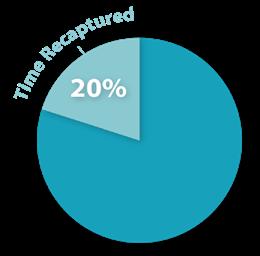
Manual processes also make it harder to add new services for your clients (and you know how important going above and beyond for your clients is, especially with the new compensation disclosure requirements).
points of differentiation,
Source:
If you’re relying on your relationships and services to be the reason why clients give you their business, think of what you could do to actually set yourself apart from the competition with more time.
This year was unlike any other for brokers.
Let’s explore a brief case study of an agency that found greater efficiency.
This agency was using non-connected solutions like Microsoft Word to complete benefit books. When they connected their solutions with an agency management system, the office recovered two hours of time per client during the critical fourth quarter.
Now, two hours may not seem like a lot of time, but there are only 510 hours of time available per employee during each quarter. Since the agency has 50 clients, that’s 100 hours of time (or 20%) that was recaptured.
That extra time allowed the agency to bring on more clients and also have more time to perform proactive services to protect their book of business. What would you do with the extra time?
Now that you know the importance of investing in systems that will make your insurance agency more efficient, here’s how you can spend less time copying and pasting and more time actually caring for your clients.
First, take inventory of every routine
service you perform related to servicing each client, such as:
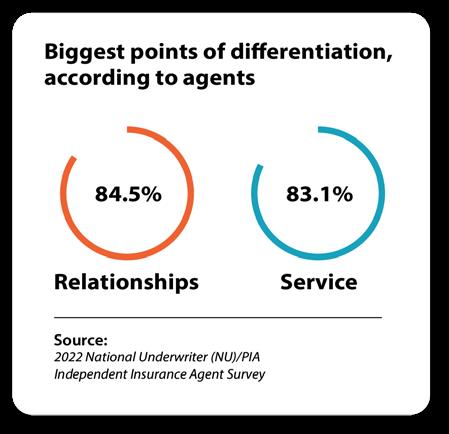
• Benefit books
• New commission disclosures
• ERISA compliance documents
• Wrap documents
• Eligibility systems
• Tracking service issues
• Commission tracking
Then, note next to each task which platforms are required to complete these functions, for example:
• Document creation platforms (Microsoft Office, Adobe)
• Customer relationship management (CRM) software
• Benadmin systems
Pay particular attention to which of these functions are in non-connected solutions (i.e. not tied to a database).
Next, determine which of these services can be made more efficient by eliminating duplicate data entry. If you enter one piece of data once, how many other processes does it need to be translated to?
The goal of this exercise is to eliminate as much duplicate data entry as possible (like having to tell your ERISA third-party administrator the client’s
address, which plans they have, their EIN, etc.).
An insurance agency gains efficiency by utilizing solutions that allow you to update data once and deploy it across several processes.

Duplicate data entry across nonconnected systems is bad for the agency. Instead of winning new business and wowing clients, you’re hitting Ctrl+C and Ctrl+V all day long. Consider how technology like an agency management solution can help you modernize your firm and provide better service.
TOM AVERY is the founder of Innovative Broker Services, a boutique brokerage company and a Top-10 Employee Benefits Agency for 12 consecutive years (Sacramento Business Journal). Tom is also the founder & president of Signal Sync, an insurance industry SaaS and agency automation solution designed for the independent agency. Tom continually writes regarding the many challenges faced by today’s agencies and has developed Signal Sync to overcome these challenges.
Contact: www.innovativebroker.com www.signal-sync.com
 BY RICHARD SHAFFER
BY RICHARD SHAFFER
For brokers in the employee benefits market, 2020 accelerated and exploited trends, like virtual work, that were already slowly and steadily disrupting the market. Visiting worksites, hosting conference room benefits meetings, and conducting in-person enrollments were no longer possible. At the time, brokers generally fell into two primary camps: those who rolled with the punches, and those who clung to old ways. As we approach a new year, the same choice is in front of many brokers today.
Amid the pandemic, the former group of brokers — those who rolled with the punches — used technology to their advantage. Through tools like video conferencing and virtual enrollment platforms, these brokers quickly pivoted to meet their clients’ needs.
Smaller brokerages or independents who didn’t have access to such technologies adapted by leaning on insurance carriers with technology resources, or by merging with larger employee benefits brokerages. Currently, this is the most active merger and acquisition environment I’ve observed in my nearly two decades in the business. Throughout the pandemic challenges, these brokers were able to grow business, gain new clients and drive revenue as employers looked for ways to support and remain engaged with workers during those troubling times.
The brokers who clung to old ways, didn’t adapt to new technologies, didn’t seek solutions to new pain points, likely lost business and struggled to grow. As employers sought brokers who could meet their rapidly changing needs, those who didn’t pivot lost accounts and revenue.
3 ways brokers can help clients navigate workplace challenges
In the past two years, new pressures have emerged because of macro issues, including the Great Resignation where record numbers of employees up-ended or changed their careers. Labor shortages and economic uncertainty have also created a volatile world of work that employers are still figuring out — and brokers today play an important role in helping employer clients overcome these challenges. Just like when the pandemic hit, brokers who rise to the challenge will mitigate their risk of receiving the dreaded broker of record (BOR) letter ending their engagement.
As 2023 comes into view and employers continue to set the bar high for brokers handling their business, here are three ways brokers can help clients navigate today’s workplace challenges.
1. Brokers should be equipped to service onsite, remote and hybrid employees.
Although much of society has opened back up, businesses in 2022 are still a mixed bag of remote, onsite and hybrid work. According to a Gallup study, “The Future of Hybrid Work,” 53% of remote-capable employees expect a hybrid work arrangement, while 24% expect to work exclusively remotely. This is nearly double the number compared to prepandemic numbers.
Brokers must be equipped to help employers engage with onsite and remote employees, so an effective engagement plan is key and should include:
Multi-layer communication to get employees engaged and ready for enrollment, including voice broadcasts, videos, text messages and emails.
• Ways to provide a personal experience at scale despite the various places employees work.
• Virtual or onsite personal benefits support sessions that help employees understand their options.
• Online enrollment guided by benefits educators or via self-service.
During the Great Resignation, millions of America’s workers quit their jobs. One study from the Pew Research Center cites that nearly a quarter of workers who resigned in 2021 say that benefits were a major reason why they left.
As companies struggle to find and keep talent, brokers should focus on offering clients a robust suite of products that go beyond the basics, including voluntary benefits. According to the Society for Human Resource Management (SHRM), “nearly three-quarters of employees agree they’re more likely to work for an employer that offers employee-paid voluntary benefits, including critical illness insurance, hospital indemnity, disability income, or accident insurance.”
Voluntary benefits allow employees to fill the gaps in core benefits they receive, which is important in a climate of financial uncertainty. Unlike major medical insurance, voluntary benefits are paid directly to employees, not doctors or hospitals. Employees can use the benefits to help cover the out-of-pocket costs left by major medical insurance, such as
deductibles, co-pays, coinsurance, noncovered treatments and everyday living expenses.
Voluntary benefits also allow employees to curate a healthcare plan that caters to their unique needs. While younger generations of employees may be drawn to accident insurance or hospital indemnity, older generations may gravitate more toward cancer or heart/stroke coverage. Employees may also consider their unique family medical history when deciding to opt into coverage.
In addition to voluntary benefits, brokers can help employers attract and retain talent by adding non insurance products to their lineup. Identity theft protection, telemedicine and caregiver resources are just a few examples of services that are trending in the employee benefits market today.
3. Brokers should focus on benefits education, advocacy and transparency.
Nearly one-third of America’s workers admit they don’t fully understand any of the employee benefits they selected during their most recent enrollment period, according to an article by SHRM titled, “Employees Want Voluntary Benefits but Don’t Always Understand Them.” It’s only a benefit if employees understand it, which is why it’s crucial to include these strategies for your clients:
• One-on-one conversations with benefits educators can help guide employees through the complexities of healthcare benefits during the open enrollment period. An individualized approach ensures employees have an enhanced awareness, knowledge and appreciation of their benefits.
• Comprehensive benefits advocacy and education helps inform employees about their benefits AND how to use them when the need arises. Advocacy programs can help employees make the most of their coverage by helping them find providers, resolve claims and more.
Times are changing for employers and employees. Brokers are called upon to be more sophisticated, educated, and involved in the benefits process. Whether you have the resources to rise to the challenge or lean on a trusted partner to help you deliver, your business will reap the rewards of helping employers overcome their challenges.
Richard is a seasoned leader in the employee benefits industry, with 25 years’ experience in sales and distribution, enrollment, and voluntary benefits. He is responsible for Optavise’s career agency and independent partner distribution and sales.


In October 2021, my employee benefits agency was acquired by Shorepoint Insurance Services, an Acrisure agency partner, and I joined Shorepoint as an associate VP of Employee Benefits. My plan was not to retire but to work with a larger group offering more resources for my clients and an opportunity to further my career. California Broker Magazine’s editor asked me to write about my experience in a four-part series. In my last installment, I shared my process for finding the right buyer. In this fourth and final installment, I’ll share some of the emotions I went through during the acquisition process, and some things to keep in mind if you are considering your own sale. Many people advised me that selling my book of business would be a stressful process. I experienced a huge range of emotions during the year that it took to identify a buyer and finalize the sale, including:
● Excitement - that I had clarity on the next phase of my insurance career
● Overwhelm - when an entire acquisition team started requesting information during the due diligence process and I needed to respond to them quickly while continuing to handle the day-to-day requirements of my agency
● Defensiveness - when the acquisition team reviewed my financials and asked me (reasonable) questions that required me to articulate decisions I made about my business
● Frustration - over last-minute document requests from the buyer that delayed the closing, and dealing with an uncooperative business bank that had trouble producing confirmation of a paid-off loan
● Insecurity - when I had to hold my own with attorneys, financial analysts, compliance experts and others on an experienced corporate acquisition team (hello, Imposter Syndrome)
● Pride that I built something from the ground up that had value and was worthy of being purchased
● Elation and relief - when the deal finally closed
Overall, the entire process was an emotional rollercoaster. I reminded myself constantly that this was the biggest business deal I would probably ever make, and so the emotions were reasonable and warranted. For the buyer, this was something they did hundreds of times each year, and everyone I was working with was handling multiple acquisitions at the same time, so I couldn’t expect them to have the same level of intensity that I did. It was very helpful and reassuring that everyone I worked with during the process was kind, patient and encouraging, which solidified my decision.
I also brought in two professionals who represented and supported me. My financial advisor and my business attorney guided me through the process, looked out for my best interests, and made space for all of my questions (and some of my emotions). When I didn’t understand a term in a contract, my attorney explained it. When I wanted to run numbers and
projections, my financial advisor reviewed them. Having my own team helped me to feel like I was on solid ground throughout the process.
And after the acquisition, there were more new emotions to experience.
• Feeling accountable to an organization for my sales wins and losses.
• Wanting to be accepted and liked by my new team and feeling like the “new kid.”
• Looking for new ways to build credibility and maintain trust.
• Going from an environment where I had all of my systems and processes in place, to one where I had to start over and learn new systems and processes.
But the most significant emotional impact of the acquisition was the one I didn’t see coming — the ways in which I feel reenergized and re-engaged with my insurance career. I have new value I can offer to my clients in the form of improved service, additional lines of coverage and stronger carrier relationships. I have new opportunities to generate revenue. I have a team of really smart people who are invested in my success, who share my wins and losses, who have strategies and solutions that make me a better broker. Rather than using the acquisition as an exit ramp, I have used it as a launching pad for a new phase, and I couldn’t be happier.
I hope you’ve enjoyed this series on my agency acquisition, and that it has given you some things to consider if you are positioning your own agency for sale.
AMY EVANS has more than 20 years of experience in the health insurance industry simplifying employee benefits for employers and their employees. In October 2021, her insurance agency was acquired by Shorepoint Insurance Services, an Acrisure Agency partner, and is now operating under the Shorepoint name. As an associate vice president with Shorepoint, Amy works with employers to help them navigate the complex world of employee benefits, business insurance and risk management.
Amy is passionate about empowering professional women to network more effectively. In 2019, she started The AlignWomen Podcast, which features female entrepreneurs, leaders and other professionals who have demonstrated agency and innovation in their personal and professional lives.
Amy is a frequent speaker, writer, podcast guest and social media participant and you can find her engaging regularly on a variety of topics including health insurance issues, entrepreneurship, social media strategies, women’s empowerment and networking with intention.
Contact: 1 (323) 633-2263 amy@shorepointinsurance.com

A conversation with favorite mentors Bruce Benton and Pat Griffey
Look for a commentary in part two by Joe Navarro in January 2023
BY DAWN M C FARLANDAs we conclude 2022 and prepare for 2023, I find myself naturally evaluating how the year went professionally and personally. The demand to grow and adapt has been a firehose to the face for the last three years — with little break in between. Reflecting on the past 10 years of leadership in the industry professional organization, I have witnessed an evolution in intention to embrace change. I see a desire to repair possible divisions created or REVEALED in these tumultuous times so the future generations would have a different more constructive experience.
I am a GenX (1975), sometimes referred to as an Xer. I was fortunate to have a really good relationship with my maternal grandfather who had a Depression Era mindset — his parents worked on a farm in Nebraska and lived in a small house on that farm with 10 children.
AND I learned years ago that next generations (Y, Millennial and beyond) would grow up with a completely different experience. This would shape how they perceive the world, and how they will show up in it. Now we will have an entirely NEW generation shaped by growing up in a global pandemic. We are going to continue to see evolution. My hope is that we can all work together and avoid past mistakes, while creating a
better future for everyone.
To further that intention, I am sharing a conversation with two of my favorite mentors, Bruce Benton, past CAHU and NAHU president and Pat Griffey, past NAHU president, along with commentary by life coach Joe Navarro to be continued in the next issue, January 2023. Both Bruce and Pat have a passion for our association and its leadership. I was honored and curious to explore their experiences about years of leadership service at ALL levels — from local to national.
Here are excerpts. To watch the entire interview go here: https://bit.ly/3GvlPTR
Dawn: Hi Pat and Bruce.
Thank you for being willing volunteers for this interview — and thank you authentically sharing your perspective on what you see happening in volunteer leadership in our industry. You have both served at many levels in the National Association of Health Underwriters (NAHU) — as of Jan. 1, renamed National Association of Benefit and Insurance Professionals (NABIP) — all the way to the top as national presidents. And you both served in VERY different times.
You have been dedicated leaders in our industry for many years. For readers reference, Bruce’s years of service with NAHU spans 2008 to 2020, serving as president, treasurer then president again. Pat’s service
spans from 2017 to 2021, as NAHU vice president, president, treasurer, then president again.
1.Bruce, let’s start with you. Will you describe some of the differences you see in volunteer leadership specifically, from the time you served as national president to now?
Bruce: I see the same traits today — everyone wants to do a good job, wants to be a “servant” leader and collaborate. With fewer independent agents and more people working as employees, agents have less flexibility with their time. There is also a lack of historical perspective in our leadership, and I think people CRAVE that.
2. Dawn: Pat, your leadership as president and past president went right up through the pandemic in 2021. What changes do you see in
the new generations coming into the industry?
Pat: I see HOPE. They seem more than willing to step into leadership.
3.Dawn: What do both of you feel the next generation needs from the experienced leadership in the industry?
Pat: A leader’s FIRST responsibility is to find their replacement. AND I would like to see more seasoned leaders hop onto the mentorship wagon.
Bruce: As I said, people crave historical perspective. I think the leaders of today are seeking and thirsty for clarity and direction. In our era, the insurance industry was a noble, highly respected profession.
I have heard different perspectives on something that I feel we struggle with — not only in volunteer leadership,
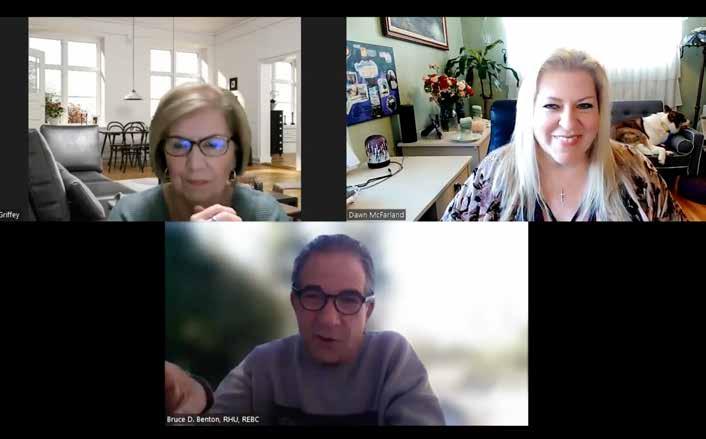
but in business across all industries. I even saw a Dr. Phil Special on it. The perspective of generations just entering the market is that people are holding on way too long to positions (both workplace and volunteerism) which does not allow for the next generation to continue their growth. And on the flip side, we KNOW people are working longer than ever before and need to, to survive. My next few responses will be from this perspective.
4.Dawn: What responsibility, as people in volunteer leadership, do we have to ensure the next generation has the tools to help them?
Pat: Let me put this out there. To all my boomer friends, we have a great responsibility. New people (not necessarily “young” people) don’t come into the industry to fail. They simply don’t know what they don’t know.
Bruce: We need to introduce ourselves and are responsible for putting our hand out. And the association needs to be devoted to developing mentorship.
“I am a superfan of our trade association for a lot of reasons. The most important is the mentorship (often turned to friendship) that has helped me grow both professionally and personally.”
— Dawn McFarland
5. Dawn: How do we make sure we are teaching and sharing our experience? How do you handle it when you don’t feel heard when you are trying to share experience? My philosophy is to caution others – NEVER say WE’VE ALWAYS DONE IT THAT WAY – LOL. What is the most respectful way to have these conversations in mixed rooms to avoid offending the experience in the room, while also opening the doors for new leaders to rise?
Pat: Not everyone is interested in or cut out for leadership, and I think we tend to push EVERYONE to be a leader. But there’s a lot people can do for the association without becoming a leader – just JOINING like Bruce said, makes a difference. The new folks want to know WHY they are doing what they’re doing – not just being told what to do. That’s the biggest problem I see a lot of seasoned leaders doing – thinking like a parent. It no longer works to just say, “Go this because it’s the way we’ve always done it.”
Dawn: There are So many good nuggets in that.
Pat: Simon Sinick, author of “Start With Why” came to NAHU as a speaker and started a seismic shift. Most people can tell you what or how, but few can say WHY. That’s what separates previous generations from this generation coming in. They want to know WHY first. And we are starting to do that. WHY is at the heart of the Vision 2025 planning, including the name change. There’s SO many transformations taking place. It’s been a phenomenal trip.
6. Dawn: With technology, working from home and demanding
more balance in life — what are the pros and cons in volunteer leadership AND in general? How do these changes impact how we interact as a volunteer organization?
Bruce: This worries me a lot. Virtual attendance is necessary since the pandemic — it even opened the opportunities for more to join. The answer is we have to meet people where they are.
Dawn: Yes, I agree. Our job is to go to where people are and let them know what we are working on. IF they KNEW I believe they would engage. Our mission is INDUSTRY WIDE, so if they knew what we are advocating for, and the fact that if they were a part of us, they would be influencing what happens — and they would find that they are very welcome.
Last question – what top three pieces of advice be to anyone interested in serving in leadership?
Pat: First, keep an eye to the future and be open to new ideas. Honoring that WHY was one of the key elements of Vision 2025. I’m not that smart so I had to make a platform available to innovators to share ideas.
Dawn: Wise you are.
Pat: Second – find a mentor and be a mentor. Third, allow time to dig deep and question your own preconceived notions, as opposed to taking the easy path because it is what we’ve always done. That’s not what’s going to get us where we need to be now.
Bruce: Mine aren’t so different — no surprise. First — I’ve always loved
the “servant“ leader approach — this is the approach I suggest for anyone interested in leadership. The true ‘servants’ I’ve met are in it for the right reason, they stay humble and they leave their ego at the door.
Second — I’ve always been big on clarity. Clarity is KING. I felt I could have done a better job explaining how NAHU operates from a government relations perspective — we are a non-partisan, unbiased organization of insurance professionals. Our role is to examine proposed legislation and its potential effects with a simple explanation of WHY. So simple that you could explain it to your mom without her eyes rolling up – to give legislators a clear perspective on why we feel a certain way about the effects of proposed legislation on the insurance market.
Third — be mindful of being extremely patient, tolerant and understanding of everyone you come across. Practice loving kindness and compassion, because we are all in this together.
Dawn: Thank you both for your continued service and desire to support the next generation wanting to learn from you. I admire both of you so much.
To watch the entire interview go here: https:// bit.ly/3GvlPTR
Dawn: I was surprised that Joe Navarro’s message that you’ll read about in the January 2023 issue was about mentorship and its value in NAHU/NABIP. It was not something we discussed beforehand.
Synchronistically, it has been a topic in many of the NAHU leadership committees — we now have NAHU Leadership Academy, AND we also have an active mentorship program which has been piloted for the last 18 months with mentors in leadership across the country.
The NAHU Leadership & Development committee Mentor Task Force revamped the program with help
“Allow time to dig deep and question your own preconceived notions, as opposed to taking the easy path because it is what we’ve always done. That’s not what’s going to get us where we need to be now.”
— Pat Griffey
“The true ‘servants’ I’ve met are in it for the right reason, they stay humble and they leave their ego at the door.”
— Bruce Benton
and support from the CAHU Foundation. We have joined together to help get the word out! (Shout out to Tim Kanter and Vanessa Ignacio. Thank you for collaborating and continuing to support leadership growth.)
I am a superfan of our trade association for a lot of reasons. The most important is the mentorship (often turned to friendship) that has helped me grow both professionally and personally. I adhere to the saying ”if you are the smartest person in the room, you are in the wrong room” with a caveat: if you can raise others up, you should be in those rooms sharing your experience. I’d be willing to bet we will all continue to learn a lot from each other.
So, friends and esteemed colleagues, as you make plans for 2023, please include some time to volunteer. Wherever you are most passionate, your service is needed. Be a mentor or get linked up with a mentor. Serve on a local board, or serve on a local committee. Go to the Capitol Conference in D.C. Attend your state lobbying event {CAHIP is scheduled in Sacramento for May 8-10, 2023}. All are ways you can contribute.
And if you discover a call to leadership along the way — remember the great Steven Covey quote ”Seek first to understand, then to be understood.” This will open minds and hearts.
Here is my familiar membership pitch: if you are getting a paycheck in the health insurance industry, you should be a member of the National Association of Benefits and Insurance Professionals (as of January 1st NABIP - formerly NAHU). Even if that is not where you choose to volunteer, the small monthly fee is worth the advocacy done on your behalf and for your clients.
Sending holiday love to everyone. Cheers for a fruitful 2023!
Dawn
DAWN MCFARLAND is VP of legislation for CAHU (now known as CAHIP), president of M&M Benefits Solutions in Los Angeles and the vice chair for the Leadership & Development Committee for NAHU (now NABIP).
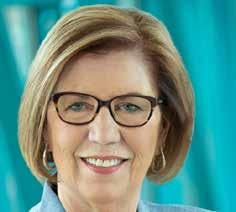

Contact: dawn@ mnmbenefitsolutions.com; 1(805) 701-1229

 BY JOSHUA SCHNEELOCH
BY JOSHUA SCHNEELOCH
Theend of year is one of the most exciting and rewarding times for voluntary benefits agents and their employer clients, as well as the workers who will enjoy enhanced worksite benefits. These benefits are specifically designed to meet their personal needs and on-demand lifestyles. In this article, I will share five tips to leverage your existing groups and substantially boost your commissions next year.
First a little industry background. Voluntary benefits are products an employer offers at a discounted group rate but are paid for (either fully or partially) by an employee through payroll deduction. They supplement other traditional benefits (health insurance, retirement, etc.) and generally don’t have any direct costs to the employer. Examples may include pet insurance, paid disability, tuition assistance, etc. The market size of the voluntary benefits segment of insurance, measured by revenue, is $87 billion this year, a 5% annual increase which is expected to continue to surge.
Voluntary benefits, also known as worksite benefits, supplemental benefits, or employee-paid insurance, allow employees to purchase customized insurance protection at competitive premiums and fill any gaps left by the core benefit programs. They aid employers by supplementing their benefits
packages, and thereby improve employee total well-being, while controlling health care costs. In this sense, voluntary benefits elevate employers and employees simultaneously, which makes selling these products such a perfect opportunity. These customizations benefit employers by increasing retention: an Aflac survey found that employees who were offered voluntary benefits were 19% more likely to be satisfied with their job — and 14% less likely to be job searching.
As one of the top voluntary benefits agents for AFLAC, becoming a “wingman” for Dickerson Insurance, I built my business with the following basic approaches. So whether you rep for AFLAC, Colonial, Combined, Unum, AllState, MetLive, Humana or any of the other leading voluntary benefits carriers, these simple tips can boost your book of business for 2023.
1DON’T SELL, SOLVE: This first tip may seem anathema to sales, but powerful nonetheless. What I mean is — you should approach your clients as a solution partner rather than a salesperson. Your clients have problems they need to solve, and most don’t want to hear a sales pitch. So become focused on their individual needs: employee retention and satisfaction, etc. Voluntary benefits serve that purpose and solve that problem in many ways.
2FRIES WITH THAT? Not only does Micky D’s dole out two billion burgers every year but they also sell more than nine million pounds of french fries every day. This revenue bonanza owes much of its success to employees asking a simple presumptive question: “Fries with that?” In the same way, voluntary benefits agents, who sell a small slice of the insurance pie, can simply ask, “Do you offer healthcare insurance to your team?” Or, “Do you think your team would be interested in pet insurance or travel insurance or legal insurance at a discount?” This one question can open the door to incredible commissions next year.
3RUN THE NUMBERS: Numbers don’t lie and sales of course is all about numbers. Imagine the following scenario. Let’s say if you service just one of your voluntary benefits groups with mandatory health insurance, say 25 employees. The average monthly subsidized premium is about $450. If we assume an enrollment rate of 75%, you will have about 20 employees paying $9,000 per month in premiums. At 5% commission, you will earn an additional $450 per month or $5,400 per year. That's just one group. Think of what 10 or 25 groups can do for you by simply asking a few simple questions, all incremental on top of your existing book of business, by leveraging the relationships you already have developed.
4KNOW THY CLIENT: Do regular policy reviews and service outreach with your existing clients to look for gaps in your clients’ coverage, which will open the conversation for crossselling other services. Remember that every area of need is potentially another line of business or revenue stream. Most importantly, as you solve more and more of your clients' needs, they become more and more likely to stick with you over the long haul.
5GO DIGITAL: Establish a competitive edge by increasing your digital footprint with a full automated quoting/enrollment landing page. Digital platforms have become more essential to enrollment. The research shows that 70% of enrollment is done online these days. Set up your digital storefront to simplify the customer experience during the insurance enrollment process, and expand your potential market well beyond face-to-face sales.
START TODAY! Health care enrollment is happening as you read this article. Which means you have this short window to make 2023 bigger than this year, much bigger, by using these few simple tips to tap into the vein of gold under the goldmine of voluntary benefits.
JOSHUA SCHNEELOCH is the founder and CEO of White Wing Insurance Solutions and White Wing Wealth and the author of the upcoming memoir, “The Favored Son, How a Black Orphan Conquered Europe on His Way to America.”
Website: whitewinginsurance.com joshua@whitewinginsurance.com


Many agents are reluctant to assist clients with exploring the prescription drugs plans that best fit their needs. A growing number of agents are leaving their clients to fend for themselves on the Medicare.gov site to research and secure their plans. There is also a fear of allegations due to misrepresentation because of changes in the formularies during the year or errors in the formularies on the quoting platforms at the beginning of the Annual Enrollment Period (AEP).
I strongly believe that the Medicare plan-focused agent can assist their clients find the plans (Medicare Advantage or Stand-Alone Prescription) that best fits their needs by thorough research using the drug quoting platforms, the plans’ formularies and knowledge of the various discount prescription drug programs and manufacturers programs for specific drugs.
> Make sure to secure the Scope of Appointment and ask if they would like to have you assist in their review of their prescriptions. In Medicare Advantage sales, this is a key consideration in addition to choosing physicians and other providers.
> Make sure the client provides a detailed list of prescriptions, including the name of the drug, the dosage and the frequency. Be firm in securing the right names and dosages.
> Ask if the client must take or prefers taking brand name drugs or takes the generic version.
> Also, you will need the name of their pharmacy(ies) as they may secure their drugs from several.
> Review the different coverage phases of the prescription drug program (Initial, Gap and Catastrophic) and if there is a deductible for the plan, explain how it is applied and how coverage works through phases.
> When using the quoting platforms, confirm that you have the right zip code, the correct input of the drugs with the name, dosage and frequency.
> The quoting platforms allow you to input several pharmacies — this can be helpful when comparing plans.
> If the client has a very expensive drug especially at the non preferred brand tier, you should make a habit of checking the proposed plan’s formulary to see if the drug is being shown correctly.
> Make sure you cover the tiers and if there are special requirements such as step therapy, quantity limits and preauthorization.
> When reviewing the progression of the prescription drugs purchase through the year, point out to the client that this is only an illustration. The actual costs vary when moving through the initial, gap and catastrophic phases of drug coverage — depending on their actual usage and purchase — with the pharmacy’s input in the calculation.
> Always mention that drug formularies may change during the year and along with possible fluctuation in the price of the drugs.
> In addition, remind clients that if they have a new drug prescribed during the year or there are other changes, you are always available to assist with the review of the formulary. Explain how the appeals process works for any drugs that are not on their formulary or how to navigate if they need a tier reduction consideration due to the cost of the drug.
> Clients should have a copy or know how to access the formulary for their chosen plan. Explain to them that it is their responsibility to let their physician know if their drug is covered under their plan. Doctors cannot know every plan’s formulary for each client.
The prescription drug discount programs have grown by leaps and bounds the last few years. They offer individuals viable cost alternatives. However, some may not offer discounts if the individual is on Medicare. For expensive drugs, explore patient assistant programs on manufacturers’ websites.
Here are some discount offerings you may want to explore:
• GoodRx
• RXsaver
• OptiumPerks
• America’s Pharmacy
• WellRX
• Save on my meds
• Internet Drug Coupons
• gogomeds
• SingleCare
• NEEDYMeds
• Special pharmacy programs
Be careful about some of the programs. Forewarn your clients that it is a possibility that by using a program’s online platform to obtain discounts, clients tacitly give permission for the program to provide their information to on-line quoting agencies for drug and MAPD plans.
Under the California Senate bill 393 passed in 2000, the State of California also offers a prescription drug program for Medicare recipients. The bill enables Medicare recipients to obtain their prescription medications at a cost no higher than the Medi-Cal reimbursement price for those drugs.
Medicare beneficiaries may call the Medi-Cal helpline at 1-800-541-5555 for information.
If you choose NOT to quote the prescription drug plans, please take the time to at least inform your client about the phases of coverage, how to understand the quoting information, what the star ratings mean and other key information such as when they may change plans.
For those agents who choose to provide the full service of prescription of drug review and plan enrollment, as long as you are selling compliantly and are thorough in your research and counseling, you should be well rewarded with a happy client and an ongoing relationship.
Just a reminder: make sure that you are recording your calls, documenting your conversations and touching base with your clients during the year. You differentiate yourself from call center agents because as the agent of record, you are there to provide on-going service and support. You truly can and do make a difference for your clients!
“MAGGIE” STEDT is an independent contractor/licensed agent and consultant. She is a certified senior advisor and lifetime member of NAHU’s Leading Producers Roundtable at the Soaring Eagle Level. She has over 40 years of experience in essential areas of the insurance industry including sales and sales management, product development and product management.
A dedicated leader, Maggie currently serves on the NAHU Medicare Advisory Committee. Founder of the annual Senior Medicare Summit, attendance grew from 200 in 2010 to close to 1,000 attendees in 2022. She served as past president of CAHIP; NAHU Region 8 Membership Chair 2014 – 2018 and past president of OCAHU, serving two terms.

“The Price We Pay” explains why healthcare expenses in the United States are out of control and how individuals are trying to reform how healthcare is fundamentally organized so that patients come first, and profits come second. This includes the high expense and transparency of hospital treatment, doctors doing unnecessary operations, and the fact that insurance brokers, pharmacy benefit managers, and group buying organizations do not assist the clients they serve but gain from the income they get.
For many reasons, healthcare insurance has been skyrocketing; Dr. Makary explains the money games of medicine, loaded with middlemen, kickbacks, and hidden costs, because
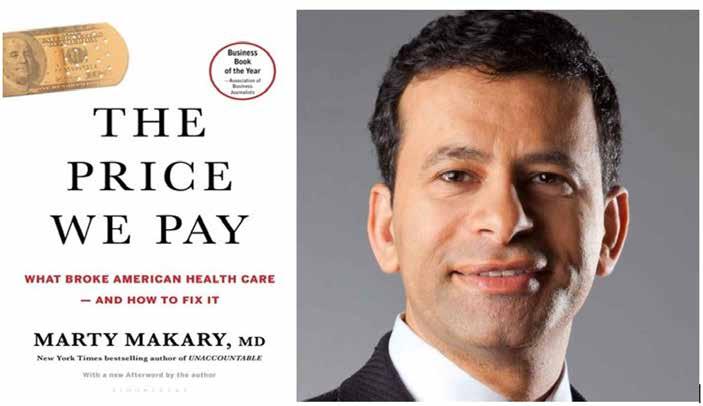
we don’t have malicious leaders in the healthcare industry.
“The Price We Pay”offers a road map for everyday Americans and corporate leaders to negotiate a better deal on their health care, and profiles disruptors who seek to change the problems with medical care. According to Dr. Makary, there is a strong movement to return medicine to its original purpose. His goal is to restore public confidence and protect our nation from the skyrocketing expense of healthcare.
Health insurance professionals can benefit from the points made by the author.
First, anybody trying to figure out new
methods to improve healthcare prices, access to care, deal with fraud and abuse, will learn from Dr. Makary’s insights and street level research. The polarizing political environment is not a solution as he notes getting the government to do anything is getting harder and harder.
Second, Dr. Makary reminds us that awareness alone may spur innovation and transformation. As advocates for our clients, we are now how the industry often pushes people around. His focus is on individual challenges fighting large systems such as hospitals and insurance carriers.
Regarding the author’s comments about the uninsured, this is why I wanted to include California statistics not included in the conclusions in the
“The
Stories of disruptive healthcare innovators and the new movement to restore medicine to its primary mission to help people
book. To be fair, the focus is on systemic problems at a national level.
The following section is my review of California issues with health insurance.
● As health brokers we know the uninsured population has been reduced in California. We have an individual mandate that requires Californians either have qualifying health insurance, or pay a penalty when filing their state tax return unless they qualify for an exemption. Therefore, in most cases a hospital bill is covered at least in part by insurance. Evidence of this is how hospitals write off millions in unreimbursed medical services delivered. Hospitals do work hard to get patients enrolled into Medi-Cal when they access hospital services. The undocumented uninsured population continues to be a source of uncompensated care.
● In California, the eligible but uninsured population stands at approximately 1.7 million. These uninsured legal residents are eligible to apply for coverage through MediCal or Covered California. MediCal enrollment is currently at 13.4 million in our state. Without including ineligible undocumented persons residing in the state, the uninsured eligible percent of the total population of 39 million is 5%.
● In 2022, the push has been enrolling more people into Medi-Cal, as the monthly income for a single adult will increase to $1,564. In other words, an adult can earn up to $1,564 per month
and still qualify for no cost Medi-Cal. Health insurance enrollment in California increased in 2020 by over a million enrollees, due to growth in MediCal managed care.
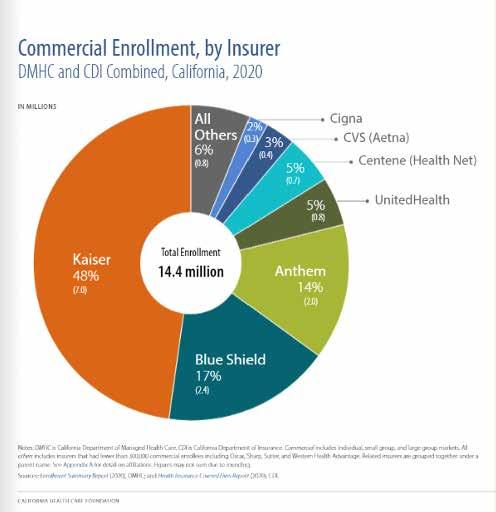
● A continued push to keep people insured is the insurance subsidy changes as those with higher incomes can often qualify for subsidized premiums for Covered California plans. And older adults can qualify for subsidies that younger adults cannot, given the same metal tier plan.
● The Affordable Care Act requires insurers to spend a minimum share of premium dollars on medical care or pay a rebate to consumers. In 2020, California insurers owed $95 million in rebates.
The top eight carriers in California equal 90% of the total market.
● Nearly 1.9 million eligible Californians will remain uninsured in 2022, or about 5% of the population age 0-64. The highest uninsured rates are undocumented Californians (65%).
Additional points on what happens to medical costs for the uninsured
● 80% of healthcare providers’ uncompensated care costs are paid by government payments designed to cover these costs.
● The remaining share of uncompensated care (about 20%) is covered by private sources, provider charity, or transferred to other payers in the health care system.
● About $8.8 billion of uncompensated care costs are not covered by public dollars. While some of this may be accounted for by public sources but those amounts are small.
● Private funding sources (e.g., workers compensation, provider charity and philanthropic organizations), may also cover some of the residual share.
● The privately insured population
assumes some of these costs through increased health insurance premiums.
● Additionally, taxpayers cover the cost for uncompensated care through MediCal or with annual insurance premium increases.
Dr. Makary points out that some hospitals and doctors are overbilling as they attempt to compensate for low or no payment from the underinsured and uninsured. He takes aim at health care providers who commit billing excesses and fraud and calls for a movement to demand change, which is commendable. The extent of fraud and abuse he reveals is staggering. Dr. Makary and his research team have made a significant impact on hospitals and physicians to influence change from practices which are not patient focused but profit driven.
“The Price We Pay” is a solid look at the healthcare industry. As health insurance professionals it is clear we can be part of the solution. The author has many deep reviews of the industry which are lessons health insurance professionals need to be aware of to help clients navigate the industry. When we support our clients and our professional associations, we rise to a higher level. Individually we may only make a small impact but collectively we can influence politics and issues through numbers. As we move forward as difference makers in the industry, we can do more by working together to defend our critical role in the industry as educators and client advocates.
DR. MARTY MAKARY is a professor at the Johns Hopkins School of Medicine and Bloomberg School of Public Health. He is author of the New York Times bestseller, “Unaccountable.” A leading voice for physicians in The Wall Street Journal, The New York Times, and USA Today, Dr. Makary is editor-in-chief of Medpage Today. He currently serves as chair of the advisory board of African Mission Healthcare. He lives in the Washington, D.C. area.
PHIL CALHOUN is co-owner of Integrity Advisors and publisher of CalBroker Magazine. Contact 1 (714) 664-0311
With many workers continuing to experience visual demands on their eyes, from blurry vision to eye fatigue to headaches, taking care of eye health remains an extremely important part of our overall health.
According to the Centers for Disease Control (CDC), about 11 million Americans over age 12 need vision correction, but that is only one of the reasons to get your eyes examined. Regular eye exams are also an important part of finding eye diseases — and overall health conditions early and preserving health. As we look ahead to the future, the number of blind and visually impaired people in the United States is estimated to double by 2030 and triple by 2050. Urging people to prioritize their vision health as part of their overall well-being could significantly reduce that number and improve quality of life for millions of Americans and employee productivity. (Centers for Disease Control “Keep an Eye on Your Vision Health” Oct. 1, 2020)
One of the easiest and most cost-effective early detection areas for serious illness is the eye exam. For example, one in five people with diabetes discovered their disease through an eye exam. (Harvard Business Review. “Why Vision Care Belongs at the Core of Your Company’s Healthcare Benefits” Oct. 24, 2022)
According to Transitions Optical’s 2022 Workplace Wellness Survey, employees are knowledgeable about the eye health conditions they believe can be diagnosed through a comprehensive eye exam; however, they are not as knowledgeable about overall health conditions that can be diagnosed through an eye exam. Of the employees who have access to vision benefits, respondents understood that cataracts (65%) and glaucoma (63%) could be diagnosed through an eye exam but were not as confident in their knowledge of overall health conditions being diagnosed through an eye exam, such
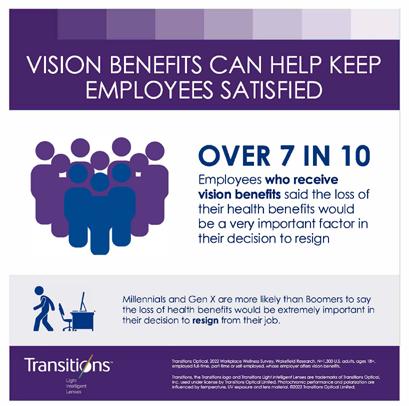
as diabetes (29%), hypertension (25%), brain tumors (16%), and heart disease (13%). (Transitions Optical, 2022 Workplace Wellness Survey, Wakefield Research, N=1,300 U.S. adults, ages 18+, employed full-time, part-time or self-employed, whose employer offers vision benefits.)
Diabetic retinopathy is a common complication of diabetes, and early detection and treatment can prevent or delay blindness in 90% of people with diabetes. However, 50% or more of people do not get their eyes examined or are diagnosed too late for effective treatment. (Centers for Disease Control “Keep an Eye on Your Vision Health” Oct. 1, 2020)
To preserve eye health an annual visit to the eye doctor is key, and the solution is simple — employees need access to vision benefits.
What people and companies may fail to remember is vision benefits are an important investment in our overall health. According to Harvard Business Review, while many people may understand the general importance of an eye exam, and 84% of people consider vision their most important sense, half still skip their annual eye exam.
In 2020 vision problems cost U.S. employers $575 billion in lost productivity, however many companies do not offer their employees vision care or encourage them to take advantage of the benefits they have. (Harvard Business Review. “Why Vision Care Belongs at the Core of Your Company’s Healthcare Benefits” Oct. 24, 2022)
Since the start of the pandemic, employees have noticed a negative impact on their eye health and productivity throughout the workday. The Transitions Workplace Wellness Survey found that 78% of employees report their work productivity and performance has been impacted by either eye strain/eye fatigue (50%), headaches (39%), blurry vision (36%), discomfort looking at bright screens (33%), and/or difficulty focusing on distance objects upon looking up from the screen (33%). Light sensitivity and digital eye strain can also lead to many problems for employees while at work, ranging from trouble seeing, to headaches, to even taking excessive breaks. According to AEIS, eye strain will, on average, lower an employee’s productivity by fifteen working minutes each day — amounting to around 65 hours of productivity lost over the course of one year.
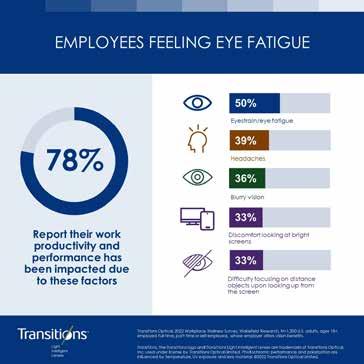
Increased symptoms of eyestrain and discomfort are likely factors in employees looking to eyewear as a potential solution. By including ancillary benefits, like vision insurance that covers eyewear and premium lens options, companies can reduce overall coverage costs, help preserve employee eye health and maintain productivity.
Companies don’t have to break the bank; providing vision insurance is a lower cost benefit, sometimes costing as little as ten dollars monthly per employee. (AEIS Advisors. “Is Vision Insurance Worth It?” Aug. 01, 2022)
And while vision benefits can help employees access eye exams, gain relief from eye strain, and increase their productivity, it also helps companies retain their employees. The current job market, “The Great Resignation, and “Quiet Quitting” are continuing to affect companies. Research from the Transitions Workplace Wellness Survey found that 38% of employees are reporting they are likely to leave their current job in the next year. Additionally, 74% of employees who receive vision benefits say the loss of those benefits would be a very important factor in choosing to resign.
Employers who offer premium vision benefits that cover both annual, dilated eye exams and eyewear options that employees both want and need can help them stand out against other companies and their competitors.
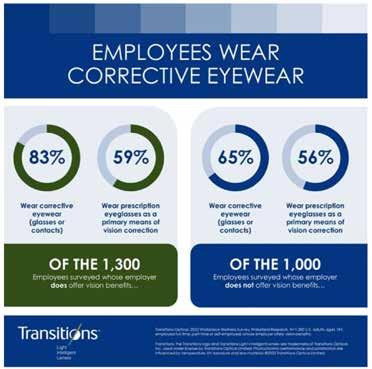
By investing in vision benefits, organizations can offer support to their workforce’s overall wellness, retain top talent, and boost productivity. By offering vision benefits and reducing health care costs overall, companies can focus their efforts on other important budgetary factors for their employees that can only lead to a bright future.
ORMSBY is a senior key account manager for Transitions Optical. Reach out to him at jormsby@ transitions.com.

chief sales officer for ARAG www.araglegal.com/

head of Supplemental Health & Life Products, Guardian Insurance www.guardianlife.com/
VP, Broker and Special Market Development, Colonial Life www.coloniallife.com/
Here’s an in depth perspective on voluntary benefits from experts in the field. We asked thought leaders to answer a series of questions to help inform you about this important realm of benefit offerings.
CalBroker (CB): What are the current trends in voluntary benefits? Are you seeing an increase in interest and offerings by employers since the pandemic?


Overall, the workforce is really fluid right now — the dynamics have changed so much for employees dealing with the seismic shift in how they’ve approached their work and balanced their personal lives. I think this has had an impact on the types of voluntary benefits they’re interested in — and how they’re using them.
Here are some high-level topics we’ve heard more about recently.
One of those topics is how benefits can be used for parents. Employees are asking, “Who else can use my benefits, such
as extended family members?” Employees are looking to get the most value out of their benefits, so I think that need will continue to grow.
There’s also a lot of discussion regarding the availability and cost of long-term care. Currently, five states are actively considering legislation to address the high cost of long-term care potentially through a long-term care state payroll tax. There are a lot of variables here, but simply put, employers are going to have to tax employees if the employees are not offered a long-term care solution.
Finally, there’s been growing concern regarding access to resources based on social determinants of health (SDOH). SDOH are the conditions in which people live, work, play and access care. Much like we’ve addressed the inequities of access to justice and the barriers people face when in need of legal help, SDOH can be a major cause of health inequities, particularly when populations do not have access to the same resources.
ARAG continues to see increased interest and growth in group legal insurance. Key trends include:
● Increased interest in coverages and services related
to diversity, equity and inclusion (DE&I) — ranging from ADA certified websites to everyday legal matters (e.g., domestic partnership agreement, gender identifier change, postnuptial agreements, veterans’ disputes, and surrogacy agreements.)
● Continued demand and need for estate planning documents, including wills, trusts, living will, and powers of attorney.
● Increased interest related to coverage for parents and/or grandparents, which is a result of the continued pressure and stress being placed on middle-aged employees, who are now providing legal and financial support to their extended family. Keep in mind: more than 1 in 4 Americans now live in a multigenerational household.
● Greater demand for services to be delivered in a manner that best meets the member where they are when they want them, which has resulted in increased use of digital tools, such as emails, video calls, mobile apps and online do-it-yourself (DIY) docs.
through an engaging and flexible enrollment experience.
CB: Have you made sure your marketing materials are easy to understand, and your enrollment process is simple? How many languages are available for your information?
When partnering with clients, our goal is to help them educate employees about legal insurance so that 100% of their workforce is able to make an informed, confident decision when it’s time to enroll. To do this, we help them:
● Communicate with eligible employees — both early and often.
● Engage and educate employees in the ways that work for them, whether it’s online, through social media, in print or in person.
● Use an array of ARAG-designed materials to help spread the word and boost familiarity with our product.
DAWN SANDT, HEAD OF SUPPLEMENTALGuardian has seen an increase in interest by employers and employees since the pandemic for voluntary benefits. In fact, according to Guardian’s 11th annual Workplace Benefits Study, nearly half of workers say that having access to benefits through their employer is more important since the pandemic. And 6 in ten employers agree that supplemental health benefits help them meet employees’ need for greater financial health. Our research also revealed that the percentage of workers who have critical illness and hospital indemnity insurance increased 36% between 2019 and 2021, likely due to the pandemic.
ROB QUELL, VP, BROKER AND SPECIAL MARKET DEVELOPMENT, COLONIALIn whatever mediums the client chooses to convey our plan information, we strive to create the greatest clarity — in as few words as possible – about the value that legal insurance offers.
Guardian has seen an increase in interest by employers and employees since the pandemic for voluntary benefits. In fact, according to Guardian’s 11th annual Workplace Benefits Study, nearly half of workers say that having access to benefits through their employer is more important since the pandemic. And 6 in ten employers agree that supplemental health benefits help them meet employees’ need for greater financial health.
ARAG has a limited selection of marketing communications in a language other than English. ARAG provides Spanish language versions of our Open Enrollment Flyer and enrollment form (if applicable) to the HR team. We recommend eligible employees and members who are not native English speakers call our Customer Care Center where we can use our in-house staff or an interpreter to answer questions or fulfill member needs. Additional Spanish language materials can be created upon agreement with the client and ARAG. The client may incur an additional cost for these materials.
— Dawn SandtMore than ever, employees want and need voluntary benefits that offer them the flexibility to personalize their benefit options for their unique needs, and we are seeing that play out in the rate at which employers are offering voluntary benefits and employees are participating in them. We’ve all been reminded that life is full of unexpected moments, and employees want to feel confident they are prepared for those unforeseen challenges. As organizations continue to adjust to hybrid work environments, the need for flexible enrollment methods that ensure employees have access to benefits and education – wherever they are – has never been greater. Colonial Life leverages our expertise to provide financial protection and personalized benefits
Guardian strives to remove the barriers of complexity that keep employees from choosing, trusting and using their benefits to the fullest. In our marketing and enrollment materials, we use common language that anyone can understand. In addition, we bring benefits to life for employees through stories and examples. An example of how we bring the power of simple, and storytelling together can be seen in our Simply Put video series. The series explains the value of voluntary benefits in simple terms that help empower employees to make informed decisions about the benefits offered to them.
Guardian provides a variety of resources and tools to help ensure Spanish-speaking employees get the most value from their benefits, whether it’s by using an AI-powered
guided decision-making tool, or by reading product flyers and watching informative videos in their language.
Colonial Life leverages highly trained writers, consumer research and consumer focus groups to guide layout and content for our enrollment communications that are easily understood by consumers. Our communications provide clear guidance on what a consumer will need to have available for the enrollment process and the steps they need to take to make the best benefits decisions. Colonial Life’s benefit counselors can educate multilingual employees in a variety of languages. We partner with certified translation companies for language needs for specific larger clients.
CB: Tell us about your preparation and training for enrollment reps and customer service teams. Do they have comprehensive knowledge of all the products? Do they speak different languages? Are they readily accessible if brokers or members have questions on enrollment or claims?
Our benefit fair representatives are our main connection with eligible employees at benefit fairs. These representatives can answer high-level questions about the coverage information, cost of the plan(s), how to enroll, and how to get set up with a network attorney.
Our representatives need to have a thorough understanding of our product and how it can help members; that’s why they undergo an in-depth onboarding and annual training process to ensure they learn about the company, our mission and how our benefit works.
We do have an option to have a representative who is bilingual attend events if the client has a high population of employees who speak another language other than English.
When a member, broker or eligible employee wants to share concerns, receive answers to coverage questions, ask claim questions, locate network attorneys, and get advice on the most appropriate covered service for their situation, they can speak with one of our highly trained Customer Care specialists.
All Customer Care specialists are required to participate in an initial four- to six-week training program to receive extensive knowledge of our products. They also undergo ongoing training, mentoring and feedback to ensure they maintain a high level of member satisfaction and call response.
While English is the primary language spoken by our Customer Care specialists, ARAG has specialists fluent in German and Vietnamese. And we also participate in the TransPerfect Language Line Interpreting Services program, enabling us to communicate in more than 170 languages.
To maximize accessibility for members and brokers, ARAG’s Customer Care center offers extended service hours of 7 a.m. to 7 p.m. Central time, Monday through
Friday, through the toll-free number of 800-247-4184. Members who prefer email can contact customer care at Service@ ARAGlegal.com or submit their questions online via a web-based tool after logging into ARAGlegal.com. A Customer Care specialist will respond — using the member’s preferred method of contact — within eight business hours. Members may also use our web chat functionality to interact with a Customer Care specialist.
Our benefit counselors go through extensive training to learn all aspects of our products. Our customer service reps receive additional training on eligibility and billing administration. We have bilingual benefit counselors available to support Spanish speaking planholders and employees.
Colonial Life offers comprehensive and customized training for all benefit counselors. All year, our benefits counselors participate in product specific trainings. They are well versed in our complete portfolio, along with regional and local medical or core product offerings. We have over 200 benefits counselors nationwide who are bilingual and are well prepared to answer any employee questions about our online portal, premium deductions, and our claims process.
CB: What performance measures are used to track customer satisfaction?
An integral part of our “Customer-First” approach to service is to ensure members have an exceptional experience, in every interaction.
So, when members contact a Customer Care specialist, access DIY Docs® or work with a network attorney, it’s imperative to understand what they like about our services — and how we can improve. That’s why ARAG emails monthly customer satisfaction surveys to members who use our plan.
Using interactive online surveys, members rate their experience in a variety of areas, including:
● ARAG Customer Care specialists’ overall service and the respect and support offered
● Network attorney’s professionalism, knowledge, and responsiveness
Our surveys use a standard 10-point scale, where 10 indicates a member is “extremely satisfied.” ARAG believes this scale provides the best vehicle for identifying change in member satisfaction and facilitates our continuous focus on improvement. Members can also share open-ended feedback about their experience. In 2021, members scored ARAG 9.1 out of 10 for support provided by ARAG’s customer care team.
Also note that we send out an annual client satisfaction that helps us gauge our ongoing working relationships with employers and how we can improve their experience, from
More than ever, employees want and need voluntary benefits that offer them the flexibility to personalize their benefit options for their unique needs, and we are seeing that play out in the rate at which employers are offering voluntary benefits and employees are participating in them.
—Rob Quell
implementation to day-to-day administration.
Additionally, unlike many other legal plan providers, our members have the ability to provide online reviews and ratings regarding their experience with network attorneys, so that other members can use that information to make more informed decisions when selecting a network attorney to work with.
Guardian has a Voice of Customer survey program for its Group Benefits business to understand and track the customer experience across different touchpoints and constituents. We use three consistent KPIs across all surveys, which include Overall Satisfaction, Ease, and Net Promoter Score (likelihood to recommend).
Colonial Life provides superior customer service to brokers, employers, and policyholders. We set internal annual customer service goals and results are measured quarterly. Colonial Life also works with independent research firms to conduct ongoing surveys of plan administrators and policyholders and reports those results externally through news releases. In addition, all employees who have an interaction with a Colonial Life benefits counselor are asked to rate their one-to-one benefit counseling experience following their enrollment. Every account participating in the post-enrollment survey receives a
• 77% of workers say the benefits package is an important factor in their decision to accept or reject a job.
• 63% of employees say that benefits are one of the reasons they work where they do.
• 60% of employees believe that their benefits are just as important as their salary.
1. Health: Minimizing employees’ health risk and promoting well-being.
2. Wealth accumulation: Protecting employees’ income and assets with a financial safety net.
3. Security: Protecting employees’ dependents, vulnerable people, or identities.
4. Personal: Protecting things that are important to employees’ needs or individual interests.
Voluntary Benefits give employees peace of mind and freedom from the “what ifs” and chances of being consumed by worry. Overall easing financial stress by protecting their future; allowing the employee to live a healthier, happier life.
Resource: VoluntaryBenefitsAssociation.com
report card with the survey results.
CB: Are part-time employees eligible for your voluntary offerings?
HEALY, ARAG:
Yes, ARAG works with organizations to match the eligibility standards they use for other core benefits.
As supplemental health insurance benefits provide the extra support employees need, we do offer them to part-time employees. However, each employer decides who among its workforce it will offer voluntary benefits to.
QUELL, COLONIAL LIFE:
Yes, Colonial Life offers flexible benefit solutions for full and part-time employees who work at least 20 hours per week. In some cases, depending on the product and state, we’re able to offer benefit solutions for part-time employees working 17.5 hours per week.
CB: Is online enrollment required, or do you offer alternatives? How do you serve employees who either lack access or computer literacy?
We recommend clients enroll at the same time and via the same method as core benefits — and yes, we can support non-online enrollment. If a member has trouble accessing our website, navigating the different pages or understanding the content, we encourage them to contact a Customer Care specialist who will take the time to walk them through the issue and work to provide a resolution for them.
This is dependent on how the employer enrolls in their benefits. We have the option to create an enrollment form that the eligible employees can fill out and send to ARAG directly, or return to their employer to process the enrollment. Also, we have options to create an enrollment form that handles payroll deductions, or where they would pay ARAG directly. Usually, the direct payments to ARAG are done for our conversion or if the member has a leave of absence at work.
Guardian offers flexible enrollment solutions to meet a company’s needs: online (which is preferred by a majority of our customers), printable enrollment kits, and in some cases one-on-one enroller led enrollment. We also offer face-to-face and virtual one-on-one meetings to support customers and their employees.
Colonial Life offers a wide range of opportunities for employees to enroll in financial protection products. In addition to a variety of modern online enrollment technology solutions, we give employees the opportunity to engage with benefits experts that can help guide them through the decision-
making process at their convenience:
• Group Meetings: Our team of benefit experts can conduct group meeting presentations inperson or virtually, either prior to 1-to-1 benefit counseling sessions or as an alternative enrollment option.
• Custom Communications: Colonial Life can develop a personalized benefits communication and education strategy based on each group’s unique needs. We leverage email, digital postcards, custom websites, mobile apps, digital benefits booklets and more to engage employees.
When it comes to benefits, let’s face it, employees have been through a whiplash of work arrangements and economic conditions in the last few years. And with the financial impact of inflation lingering and a possible recession looming, I think voluntary benefits need to be presented to employers as much more than just an ancillary offering; they need to be positioned as a tactical, timely resource they can turn to in order to handle things in their daily lives that affect them.
— Dennis Healy• One-to-one benefit counseling sessions: They are a powerful tool to engage employees and help them understand the best protections available to them and their families.
CB: What resources and assistance with professional sales support and onsite enrollment do you provide for brokers?
When it comes to supporting brokers during open enrollment, our client managers take the lead on sending the open enrollment communication kit and supporting materials to the client. This supports the broker because it means less work for them — and ultimately benefits them because it is their client.
The biggest aspect of our support for brokers ultimately lies in the relationships our sales directors have built with them over time. It’s the backbone of our ongoing support. For example, ARAG schedules a stewardship meeting with each broker or firm in the first quarter of each year to review the status of their client’s plan, provide company updates, share our value propositions and discuss trends and issues that may impact their client.
As part of that interaction, we invite insightful discussions and can provide sales support materials.
This can include our tool kit exclusively designed for brokers working with ARAG, a great resource packed with pro tips, legal plan information and sales differentiators to help them present the strongest case possible for employers to add ARAG legal insurance to their existing benefit lineup.
Another element to our professional support is the experiences and exposure brokers get when they work with us to implement groups and the ongoing administration of the client — which helps them sell to other clients. And our support continues throughout, as we often lead the implementation calls with new clients, which takes the burden off of brokers’ busy plates.
Our benefit counselors can meet with employees in several ways, such one-onone, group meetings, webinars, pre-recorded presentations and benefit fairs. We can also provide posters, flyers, and payroll stuffers if needed.
Colonial Life’s national team of benefit experts has specialized roles they perform to support our broker partners. Sales professionals work with brokers and their clients to help develop voluntary benefit strategies that will help clients solve their benefit challenges. Account coordinators help manage enrollment logistics, benefits administration system setup/management and reporting needs. This team includes more than 5,000 highly trained benefit counselors, who can provide on-site support across the country and meet individually with all employees to educate them on their benefits (including core insurance products not offered by Colonial Life), help uncover any unmet needs and select insurance plans to meet those needs.
CB: What changes do you see in the future for how voluntary benefits are sold and serviced?
We’ve found that in general, employers’ timelines for making benefit decisions and the implementation process overall, are getting shorter and shorter. So the ability to get a plan up and running quickly, and the ability for an employer to say “yes” to installing a legal plan — and two weeks later go into open enrollment is a real thing. I feel like all benefit providers are facing that same time crunch and benefit demand and as a result, need to be ready to respond even quicker, and with less information from the employer — it’s a challenge but also an opportunity to show them you are ready to partner with them at the speed of their decisions.
And when it comes to benefits, let’s face it, employees have been through a whiplash of work arrangements and economic conditions in the last few years. And with the financial impact of inflation lingering and a possible recession looming, I think voluntary benefits need to be presented to employers as much more than just an ancillary offering; they need to be positioned as a tactical, timely resource they can turn to in order to handle things in their daily lives that affect them.
For example, when it comes to wellness, an employee can’t wait a month to see a counselor regarding their mental health. A tele-health option through their company’s EAP could help them address their issue much sooner. Or offering a college student loan debt payment program can help reduce their financial worries, they can even use a legal plan to help them get ahead of issues such as debt collection or home foreclosure.
Regarding employee demographics, Gen Z employees
who have recently entered the job market will make up 30% of the workforce — and have decidedly different needs and approaches to benefits. For example, with a legal plan, they may not use a legal plan to create a will necessarily, but may need it for consumer protection issues like a tenant dispute — or want to use it to help their parent work through an estate planning issue.
Additionally, Millennials are finding themselves under increasing pressure as part of the sandwich generation, as the pandemic illustrated, taking care of both of their kids and parents or grandparents. They are going to need continued support and resources to help them balance all that’s going on in their lives. For example, it might be easier to get coverage through a legal benefit than trying to search on their own for all of these legal services their parents may need.
Wallet share will always be a decision point for the vast majority of people when they enroll in benefits. I think that’s why there’s no better time than the present to demonstrate the value of voluntary benefits and their ability to provide people with the resources and resolution they need to handle day-today life.
Many organizations want to better support workforce well-being through enhanced policies and expanded resources. One of the approaches employers are taking is in the form of voluntary or employee-paid benefits. Given the valuable protection voluntary benefits provide, we don’t see demand for the products waning.
In the future, companies can narrow the gap between how employees prefer to enroll and how they actually enroll in benefits. With 68% of employees indicating they prefer to enroll in benefits via a digital method, companies will need to deliver enrollment experiences that optimize their benefit communications and offer enrollment processes that feel as simple and intuitive as their everyday online shopping experiences.
Colonial Life is closely watching a few key trends in the insurance industry that we anticipate will continue to influence the future of Voluntary Benefits. There has been a rapid expansion in the number of insurance carriers, brokers, and other intermediaries offering VB products, which we expect will continue to rise over the next 18-24 months. We’re also starting to see some shifts away from typical loss protection and toward total employee wellbeing. Some carriers have introduced (and we’ve even deployed some of our own) solutions where medical insurance claims activity can be monitored with employee permissions to proactively alert the employee of additional voluntary benefits for which they may be eligible.
Thank you to Dennis, Dawn and Rob for offering their insights.
Krystie Dascoli, Boston-based practice leader, voluntary
Courtesy of www.buck.com. Full report:buck.com/report2022-wellbeing-and-voluntary-benefits-survey/
benefits, at professional services firm Marsh McLennan Agency and executive board president at the Voluntary Benefits Association, shared six tips to help employers evaluate their voluntary benefits program.
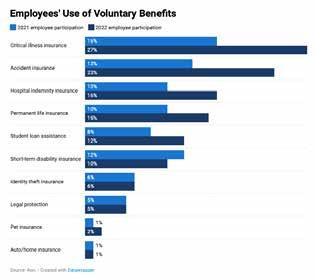
1. Understand workforce demographics. Breaking down your workforce by age, gender, salary and location can help ensure benefits offerings are meeting employees’ needs so that employees find value for the premiums they’re paying.
2. Find the gaps. Employers may offer a high-deductible health plan with a partially funded health savings account (HSA) and think that they’ve filled a benefits gap, but many employees deplete their HSA funds each year.
Supplemental accident, critical illness or hospital indemnity coverage provides financial protection so HSA dollars can continue to grow. Other employee savings opportunities include offering employer discounts on auto and home insurance, as well as purchasing programs that let employees pay over time.
3. Benchmark, benchmark, benchmark. Benchmark voluntary plans against industry peers and review them periodically to identify whether they include best-in-class offerings. Carriers are continually introducing new benefits that aren’t always added to existing plans.
4. Communicate information. The more employees understand their benefits, the more they’ll use them and find them valuable. Use and evaluate a multifaceted communication strategy that explains how voluntary benefits can meet employee needs during every life stage.
5. Ensure integration. Is enrollment aligned with the core benefits or do employees need to link to another platform? Is the same true of filing claims?
Integrating voluntary benefits with core benefits enrollment and claims filing emphasizes that these benefits work together.
6. Conduct a compliance review. Review all plans annually for compliance withfederal and state laws and regulations.



